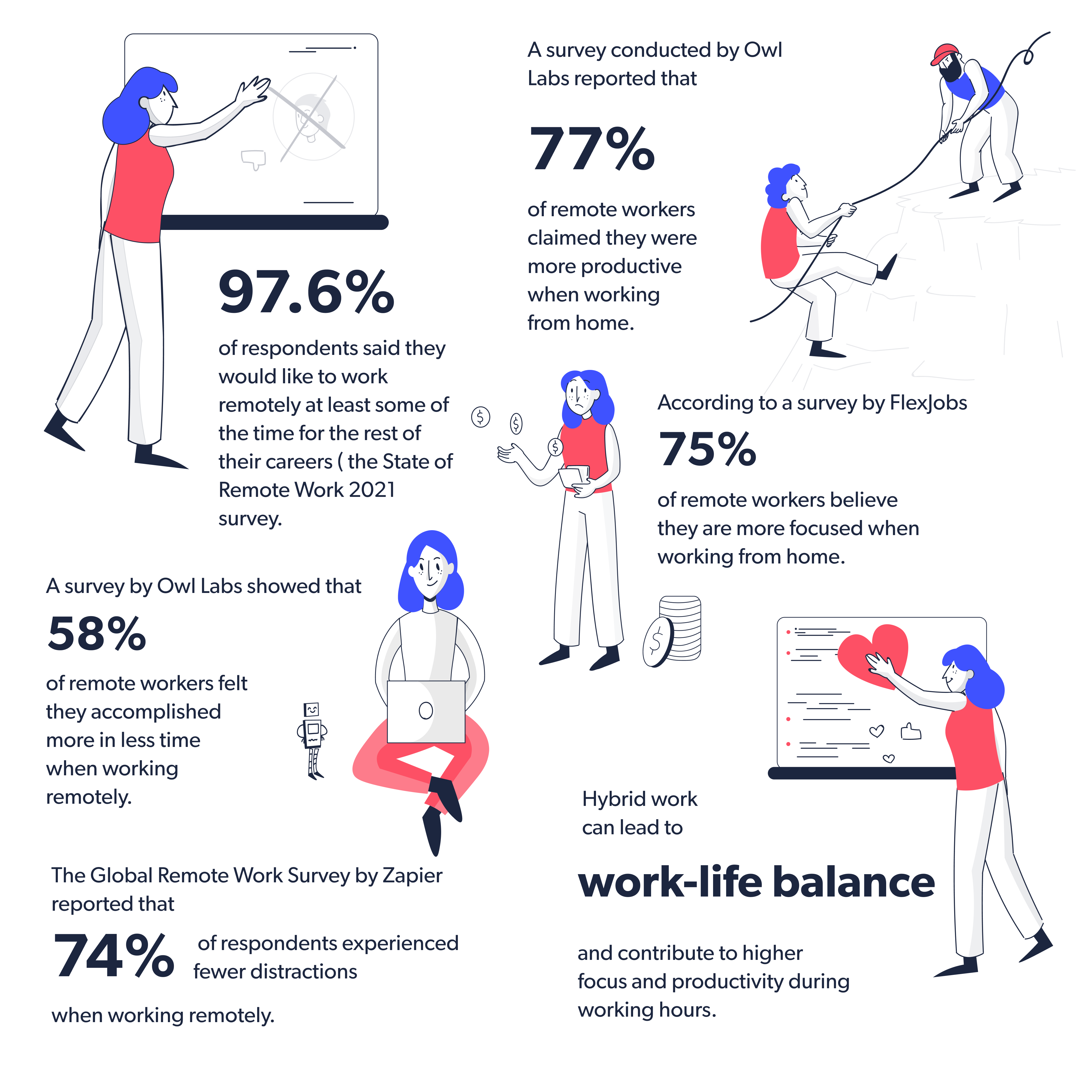Unveiling the productivity paradox in hybrid work: Challenges and strategies
The more hybrid, the more productivity paradox?!
It’s believed that with greater power comes greater responsibility. Similarly, there is a common notion that in order to achieve more, one needs to work extensively, sometimes disregarding the importance of working smart and putting in more hours only within the confines of an office.
For example, until 2020 (before the COVID-19 pandemic), most companies and employers saw no remote or hybrid work prospects. Most of the companies practiced only the work-from-office option. However, after all, we had to change the way we work. Many companies have implemented hybrid work models that offer employees the flexibility to work from home or in the office. While this model has many advantages, it also creates challenges that can hinder productivity, known as the productivity paradox.
Вut don’t blame the work style; blame the approach or its absence.
We’ve put together this article to discuss why productivity paradoxes appear in the hybrid work culture and how they might impact the workplace. We also provided some thoughts on why employees and employers have different visions about success at work and shared some tips on measuring and dealing with the productivity paradox.
What is the productivity paradox?
“Working from home improves productivity.
Working from home impairs productivity.” — Matthew Boyle, Senior Work Shift Reporter at Bloomberg News.
Both statements represent the two most popular thoughts of employees and employers. According to the WFH (work from home) research group on remote work in 2022 by Nicholas Blum, when you ask individual employees to rate the impact working from home has had, more than eight in ten employees say it has either made them more efficient or had no effect. However, more than a third of employers say working from home had, in turn, a negative impact on their business. So, what is the productivity paradox about? Simply put, all people are different. Thus, someone is much more productive only in the office, while others feel better working from home. One more example, certain types of work can be performed from any location, while others require the employee’s physical presence in an office, warehouse, or similar setting.
While many employees feel more productive when working remotely, some employers may be concerned about maintaining productivity.
Thus, the concept of the productivity paradox stems from the assumption that hybrid work can enhance productivity through various factors such as reduced commuting time, increased flexibility, and improved work-life balance. However, organizations may not always see the anticipated productivity gains in practice. Instead, they may encounter challenges and potential drawbacks that can offset the expected benefits.
One possible answer to why the responses of employers and employers may differ is because, in many positions, it can be difficult for managers to know whether employees are absent when they are working remotely or otherwise get an idea of their affairs since attendance checks are one of the main tasks of managers. Plus, traditional performance metrics designed for in-person work environments may be less effective in hybrid work arrangements. Thus, HR managers and business leaders should explore new ways to measure and evaluate productivity and performance in a hybrid context, focusing more on outcomes and deliverables than on hours worked.
Measure productivity in your organization by assessing the skills gaps
Conducting a skills gap analysis is crucial for the business. By identifying the areas where individuals and teams lack the necessary qualifications or skills, you can develop targeted training programs to enhance their abilities. Feel free to download our complimentary skills gap analysis template, which can be customized to suit your specific needs.
Productivity paradox challenges and benefits for the organizations
The productivity paradox of hybrid work culture can have significant implications for the new world of work (post-pandemic labor market). As organizations adapt to the changing work landscape, understanding and addressing the productivity paradox becomes crucial. Let’s see how it can influence the new world of work:
- Performance and competitiveness. The productivity paradox can impact an organization’s overall performance and competitiveness. However, if productivity improvements expected from hybrid work aren’t realized, it may hinder the organization’s ability to achieve its goals and stay competitive.
- Work-life integration. Hybrid work is often seen to improve work-life integration by providing flexibility. However, if the productivity paradox persists, employees may find separating work from personal life challenging, leading to longer working hours and burnout.
- Organizational culture and collaboration. The productivity paradox can affect organizational culture and collaboration. However, if remote and in-person employees struggle to collaborate effectively, it can impact the organization’s overall team dynamics, innovation, and knowledge sharing.
- Talent acquisition and retention. The ability to offer flexible work options, including hybrid work, has become an essential factor in attracting and retaining top talent. If organizations cannot address the challenges associated with the productivity paradox, it may affect their ability to attract and retain skilled employees who value work flexibility.
- Technology and infrastructure investments. The productivity paradox can influence organizations’ investments in technology and infrastructure. Companies may need to invest in robust communication tools, cybersecurity measures, and reliable connectivity to enable practical hybrid work.
- Policy and regulation. The productivity paradox can influence policy and regulation related to hybrid work. Governments and regulatory bodies may introduce guidelines or regulations to address the challenges associated with hybrid work and ensure fair treatment, employee rights, and work-life balance.
In fact, only some things are complicated due to the productivity paradox. After all, hybrid work has many advantages, and here are some of them:
- Increased flexibility. Hybrid work provides employees with flexibility regarding when and where they work. This flexibility can enhance work-life balance, reduce commuting time, and enable employees to work in environments that suit their preferences. As a result, employees may experience higher job satisfaction and well-being.
In a Harvard Business School study, companies observed a 5% productivity increase among remote workers due to fewer distractions and reduced commuting time.
- Reduced commuting and costs. Hybrid work can lead to reduced commuting time and employee expenses. This improves work-life balance and contributes to employee and organization cost savings. Employees can save on transportation costs, while organizations can reduce office space and utility expenses.
A study by Global Workplace Analytics estimated that employers could save over $11,000 per year for each employee who works remotely half of the time. Moreover, businesses in the United States could collectively save over $500 billion a year if those who could work remotely did so only half the time.
- Improved focus and productivity. Some employees may find that working remotely increases focus and reduces distractions, leading to higher productivity. With the ability to customize their work environment and eliminate office interruptions, employees can allocate their time more efficiently and achieve higher output.
A study published in the Journal of Occupational and Organizational Psychology found that employees who had control over their work environment, such as the ability to work remotely, experienced higher levels of focus.
- Expanded talent pool. Hybrid work allows organizations to tap into a larger talent pool. By allowing remote work, organizations can hire employees from different geographic locations, widening their access to diverse skills and expertise. It can enhance innovation and bring fresh perspectives to the organization.
A study by McKinsey & Company found that companies in the top quartile for ethnic and racial diversity in their executive teams were 36% more likely to have above-average profitability. Expanding the talent pool through hybrid work can help organizations foster diversity and drive innovation.
Addressing the productivity paradox requires a holistic approach, including effective communication strategies, investment in technology infrastructure, training and support for managers and employees, and fostering a culture supporting collaboration and well-being. Moreover, organizations that successfully navigate the productivity paradox can unlock the benefits of hybrid work and thrive in the new world of work.
How to manage the productivity paradox in a hybrid working environment?
To improve the productivity of hybrid workers, HR should develop plans that work for both employers and employees. So how can you solve this workplace paradox and maximize productivity in a hybrid work environment? Let’s check out a few strategies.
Establish clear expectations and channels of communication
One of the biggest challenges of hybrid work is communication. When employees aren’t physically present in the same place, it can be challenging to collaborate effectively. To overcome this challenge, it’s vital to establish clear expectations and channels of communication. It includes:
- Setting expected response times
- Taking regular check-ins
- Using technology tools such as video conferencing and collaboration software.
Prioritize mental and physical health
Working from home can blur the lines between work and personal life, making switching off and taking breaks difficult. In a hybrid work environment, it’s vital to prioritize mental and physical health. Encourage employees to:
- Take breaks throughout the day
- Establish work and personal time boundaries
- Provide resources to support mental health.
Provide the right technology tools and resources
Technology is the key to the benefits of hybrid work. Ensure employees have access to the following:
- Necessary resources, including laptops, high-speed Internet, and cybersecurity measures
- Collaborative tools for real-time document editing and sharing.
Additionally, provide training and support so employees can use these tools effectively.
Create a culture of trust and accountability
Trust and accountability are necessary to resolve workplace paradoxes in a hybrid work environment. Foster a culture of trust:
- Set clear expectations for employee performance
- Hold employees accountable for meeting those expectations
- Allow employees to communicate and build relationships with colleagues even when not physically present.
Collaborate and innovate workspace
These are key drivers of productivity in a hybrid work environment. Encourage employees to:
- Share ideas and collaborate on projects, regardless of their physical location
- Foster a culture of innovation by providing opportunities for professional development and encouraging experimentation and risk-taking.
So, what now?
The productivity paradox of hybrid work highlights the need for organizations to manage the challenges while capitalizing on the potential benefits carefully. By addressing communication gaps, fostering a strong sense of community, and implementing effective strategies for remote collaboration, organizations can navigate the productivity paradox and create a balanced and productive hybrid work culture.
To cover all the tasks for dealing with the productivity paradox, pay attention to strategic workforce planning (SWP) and tools that will allow you to automate this process. SWP is a process that helps you analyze your company’s current staffing situation and anticipate future hiring needs according to your type of work (meaning hybrid). It’s about ensuring the right number of people with the right skills at the right time so that they can deliver and you can achieve the organization’s business goals.
For example, an HRForecast solution called smartPeople allows you to take a closer look at goals you can achieve through workforce planning and measure how fast you can close skill gaps within your workforce via targeted training.
Stay up to date with our newsletter
Every month, we’ll send you a curated newsletter with our updates and the latest industry news.




























 info@hrforecast.de
info@hrforecast.de
 +49 89 215384810
+49 89 215384810






